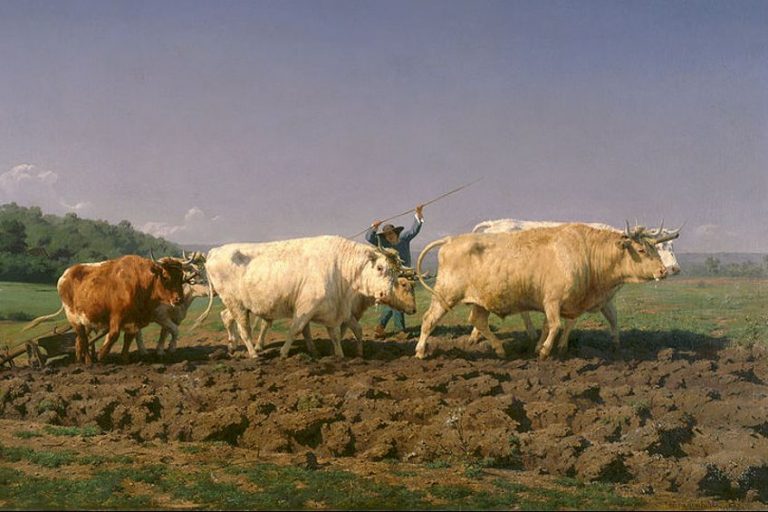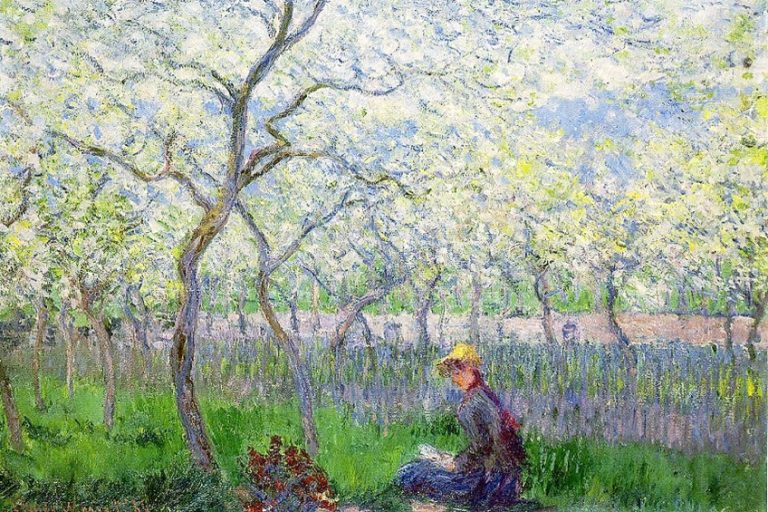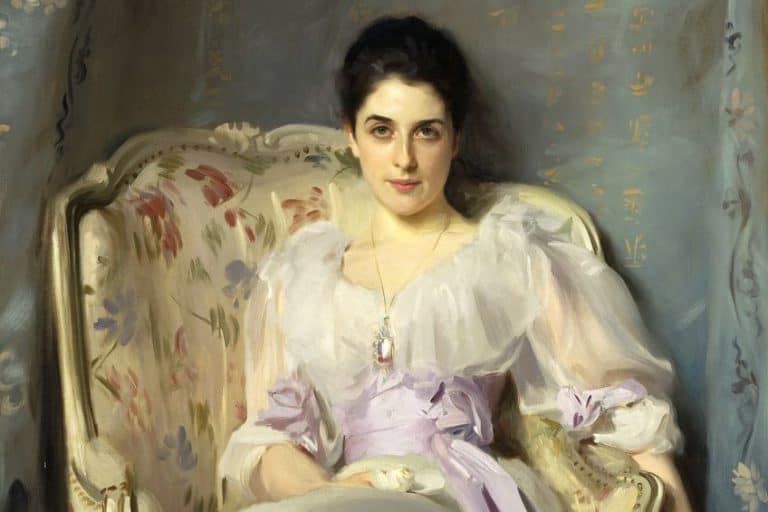“Mont Sainte-Victoire” by Paul Cézanne – An Analysis
The Post-Impressionist painter Paul Cézanne was a pioneering artist of his time and pushed the boundaries of how far Modern art could go, paving the way for future artists like Pablo Picasso and the invention of Cubism. This article will discuss one of Cézanne’s prolific painting series of the French mountain range, known as Mont Sainte-Victoire.
Artist Abstract: Who Was Paul Cézanne?
Paul Cézanne was a Post-Impressionist artist born in Aix-en-Provence in France, his date of birth was January 19, 1839, and he died on October 22, 1906. He became well known for being one of the leading artists who moved away from the Impressionistic styles of art and instead explored new modes of art that many believed set the tone for art styles like Fauvism and Cubism. He painted landscapes, still lifes, and portraits. Some of his artworks include The Card Players (c. 1890 – 1892), The Large Bathers (1898), and Still Life with Curtain and Flowered Pitcher (1895).

Mont Sainte-Victoire Series (c. 1870s – 1906) by Paul Cézanne in Context
This article will discuss the Mont Sainte-Victoire analysis by Paul Cézanne in more detail, starting with a contextual analysis of his reasons for why he painted it and how the series developed over a span of several years. It will then take a closer look at one example, namely the version housed in the Barnes Foundation collection in Philadelphia, which was painted around 1892 to 1895.
| Artist | Paul Cézanne |
| Date Painted | c. 1892 – 1895 |
| Medium | Oil on canvas |
| Genre | Landscape painting |
| Period/Movement | Post-Impressionism |
| Dimensions (cm) | 73 x 92 |
| Series/Versions | Part of a series on Mont Sainte-Victoire |
| Where Is It Housed? | Barnes Foundation, Philadelphia, Pennsylvania, United States |
| What It Is Worth | The price is uncertain. Albert C. Barnes purchased this painting on July 1, 1920, through the Galerie Durand-Ruel. |
Contextual Analysis: A Brief Socio-Historical Overview
What do Impressionism, Post-Impressionism, and Cubism have in common? That would be Paul Cézanne. He was one of the leading Post-Impressionists of the 19th century, and rightfully so, because he painted from his own unique impression (so to speak) of the world. It was regarded as a move away from Impressionism, which was the burgeoning art movement during his time, and a move towards what would become Cubism in the early 1900s.
However, let us backtrack a little bit to Impressionism because it will provide a deeper understanding of Cézanne’s stylistic approach.
This was an art style that reportedly started in the 1860s in Paris, France, by a group of avant-garde artists like Claude Monet, Edgar Degas, Pierre-Auguste Renoir, Berthe Morisot, Camille Pissarro, Édouard Manet, and others. Examples include the famous Poppy Field (1873) by Claude Monet, a street like Paris Street, Rainy Day (1877) by Gustave Caillebotte, in a café like L’Absinthe (1876) by Edgar Degas, or even watching over a baby in a crib like Berthe Morisot’s The Cradle (1872).

What most of these paintings have in common was the impression created at that moment, often with a focus on how light would affect and appear in the scene, which was conveyed through art elements like color and brushstrokes. This is also referred to as the “atmospheric” effects depicted in the scenes. What set the Impressionists apart was the en plein air approach to painting, which means “outdoors” in French. Although many scenes were outdoors, some were also indoors, and the subject matter ranged from landscapes to more general “genre” depictions.
Going Deeper With Post-Impressionism
Artists classified as Post-Impressionist went a level deeper than the Impressionist’s approach to depicting the effects of light on objects. Paintings were known to be more “subjective” and convey some symbolism, in other words, what the artist felt or saw from a more personalized standpoint. Artists reportedly also felt that Impressionist art was too “naturalistic”, and they sought to convey the “emotional” significance of their subject matter. Although there were still similarities between the two styles, like the utilization of color and brushstrokes, the latter also included a focus on more structural qualities of art making like geometric lines and forms.
Interestingly, the name Post-Impressionism was given by the British artist and art critic Roger Fry, which was from his exhibition called “Manet and the Post-Impressionists” held in 1910. This exhibition has also been known as the first “Post-Impressionist Exhibition”.
Post-Impressionism was also an umbrella term for various art styles that moved away from Impressionism. Some of these included Neo-Impressionism (also known as Divisionism), Synthetism, Cloisonnism, and Symbolism. A few of the famous Post-Impressionist artists included the beloved Paul Cézanne, who was known as the “Father of Post-Impressionism”, Georges Seurat who was associated with Neo-Impressionism, Paul Gauguin, associated with Symbolism and Synthetism, and Vincent van Gogh, who was also known for his Symbolic artworks expressed through colors and brushstrokes.
So, what made Paul Cézanne stand out as the “Father of Post-Impressionism”? His style incorporated a range of techniques, from the influences of the Impressionist focus on the effects of light towards form and structure, which has been described as a more “analytical” direction of portraying subject matter.

He opted to convey subject matter in their fundamental forms and any research about Cézanne will undoubtedly lead you to one of his widely quoted lines from a letter he wrote to Emile Bernard in April 1904 about what he believed on how to portray subject matter. He explained, “Treat nature by means of the cylinder, the sphere, the cone”. Additionally, he depicted subject matter from different angles and perspectives, bordering on abstraction in his compositions. This is additionally how he influenced the pioneering Cubist artists like Pablo Picasso and Georges Braque.
The Start of Series Mont Sainte-Victoire
Paul Cézanne started painting his Mont Sainte-Victoire series around the 1870s or 1880s, which has been categorized as his “Synthesis” phase, which was until around 1895. The second phase was termed his “late period”, which was dated from 1895 to 1906.
In November 1901 Cézanne also bought a piece of land on Les Lauves Hill, which is north of Aix-en-Provence where he grew up and overlooks Mont Sainte-Victoire. In this new space, he also built a studio where he had a full view of the mountain too, which gave him freedom and time to depict it how he wished.
Interestingly, before Cézanne focused on painting the Sainte-Victoire mountain as the primary subject matter of his series, he also depicted it in a preceding painting like Bathers at Rest (c. 1876 – 1877).
Formal Analysis: A Brief Compositional Overview
While there are over 30 oil painting renditions of Paul Cézanne’s Mont Sainte-Victoire painting, the formal analysis below will discuss the version housed at the Barnes Foundation in Philadelphia. It will start with a visual description of the subject matter followed by a discussion of the art elements that compose it, notably the colors, textures, lines, shapes, forms, and the utilization of space.

Subject Matter: Visual Description
The painting Mont Sainte-Victoire by Paul Cézanne depicts the limestone mountain in the background and as the central point in the composition. It appears as if we, the viewers, are standing directly opposite it, but from a faraway vantage point. The mountain here is further into the distance compared to other versions where it appears closer, for example in the version housed at the Bridgestone Museum of Art (previously the Artizon Museum) in Tokyo, Japan, which is titled Mont Sainte-Victoire and Château Noir (c. 1904 – 1906).
The middle ground depicts the vast and hilly landscape below our, the viewer’s vantage point, nestled under the mountain.
There are various shapes and forms scattered throughout here, which resemble houses and trees within the rolling lines of hills. The foreground consists of more trees and what appears to be the rooftop and structure of a farmhouse or villa nestled between the trees. In the lower right corner is what is described as a Roman aqueduct.

Color
The color scheme consists of combinations of natural and neutral hues, from greens, ochres, browns, and blues, with some pinks and lilacs also evident. There is a combination of warm and cool colors. Interestingly, you will notice Paul Cézanne’s application of various colors as the different versions of Mont Sainte-Victoire progressed over the years, which includes the levels of the vibrancy of colors.
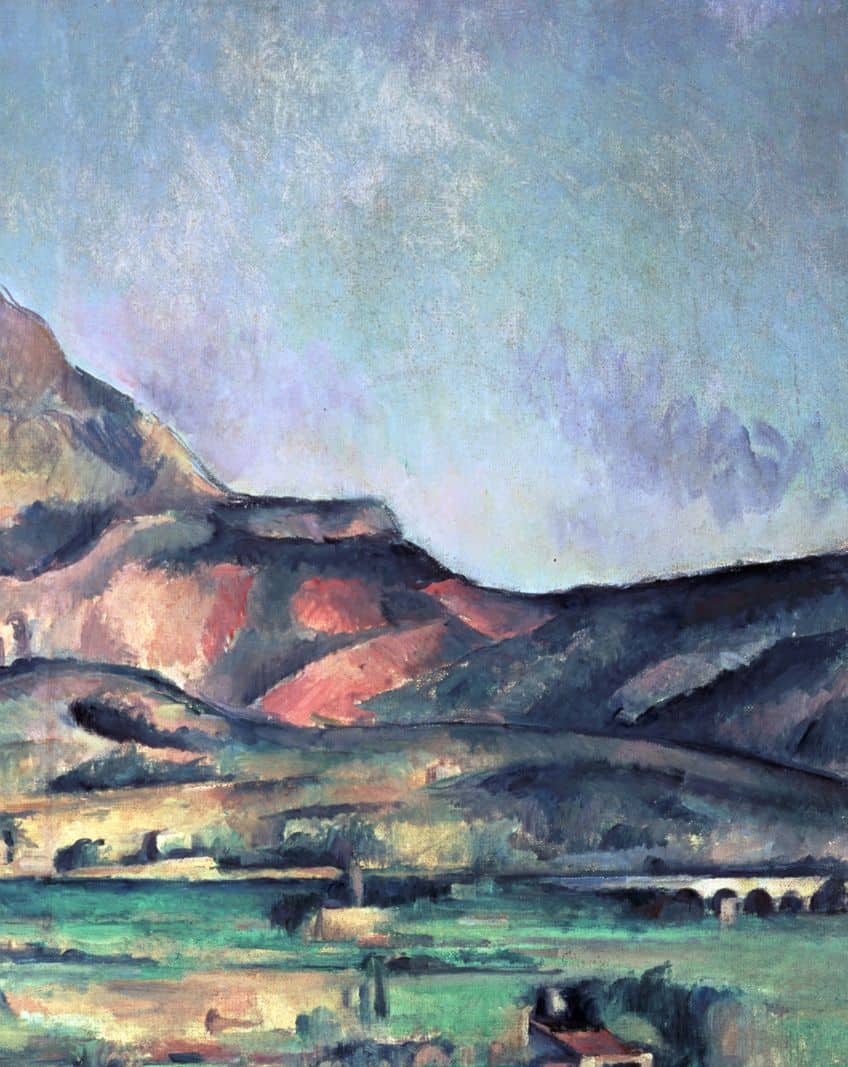
Shape and Form
The naturalistic lines in Mont Sainte-Victoire by Paul Cézanne delineate the naturalistic (organic) forms in the composition, for example, the mountain and hills in the landscape are free-flowing and curving in different directions. These are contrasted by the geometric shapes of the buildings (houses), which are square and rectangular shapes.
Furthermore, the forms and shapes are also created through other art elements like Cézanne’s application of brushstrokes.

Texture
Paul Cézanne was known for applying thick impasto brushstrokes in his paintings, and in this version of Mont Sainte-Victoire his brushstrokes are visible on the canvas, from short to long, and curved, the brushstrokes create a dynamic effect. Furthermore, the brushstrokes are also applied to convey some implied texture, for example, notice the upward strokes of the trees in the foreground or the smoother finish on the outer walls of the building in the foreground.
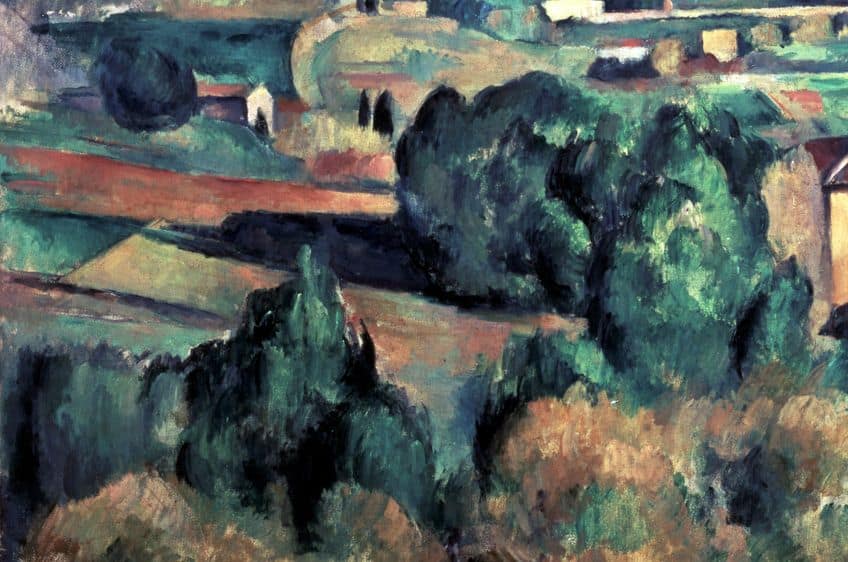
Line
There are a variety of lines created by Paul Cézanne’s brushwork in the Mont Sainte-Victoire painting consisting dominantly of organic and naturalistic lines composing the mountain, hills, and foliage. There are also contrasting geometric lines delineating the buildings’ structures scattered throughout the landscape.
The building in the foreground composed of angular vertical and diagonal lines is a notable example.

Space
The spatial composition of Mont Sainte-Victoire by Paul Cézanne depicts the landscape from an elevated vantage point, or aerial perspective, as we, the viewers, are looking down into the valley and almost directly on the same level as the limestone mountain in the background, however, the exact elevation is uncertain.

A Mountain and a “Motif”
Paul Cézanne described Mont Sainte-Victoire as a “beautiful motif” or “beau motif” in French when he reportedly viewed it from a train. He gave this mountain a demanding place on his canvases and it bore the changes in his style throughout the three-odd decades of his immersion in its majesty, truly becoming the beautiful motif he said it was.

This article conducted a Mont Sainte-Victoire analysis, and discussed why Paul Cézanne painted the works. It also discussed the version held at the Barnes Foundation in Philadelphia, bearing in mind that there are around 30 versions of the work. Mont Sainte-Victoire by Paul Cézanne was more than a series of paintings; these were testimonies to what this majestic mountain meant to him.
Frequently Asked Questions
Who Painted the Landscapes of Sainte-Victoire Mountain in France?
The Post-Impressionist Paul Cézanne painted a series of oil paintings and watercolors of the Sainte-Victoire limestone mountain in France. He started painting the series during the 1870s, until around 1906.
How Many Versions of Mont Sainte-Victoire by Paul Cézanne Are There?
There are reportedly 45 watercolor and 36 oil paintings of the Sainte-Victoire mountain by Cézanne. He reportedly created each version from varying vantage points and stylistic details.
What Style Is the Mont Sainte-Victoire Paintings by Paul Cézanne?
The Mont Sainte-Victoire painting series by Paul Cézanne were painted between the 1870s until around 1906, and are categorized as Post-Impressionist in style.
Alicia du Plessis is a multidisciplinary writer. She completed her Bachelor of Arts degree, majoring in Art History and Classical Civilization, as well as two Honors, namely, in Art History and Education and Development, at the University of KwaZulu-Natal, South Africa. For her main Honors project in Art History, she explored perceptions of the San Bushmen’s identity and the concept of the “Other”. She has also looked at the use of photography in art and how it has been used to portray people’s lives.
Alicia’s other areas of interest in Art History include the process of writing about Art History and how to analyze paintings. Some of her favorite art movements include Impressionism and German Expressionism. She is yet to complete her Masters in Art History (she would like to do this abroad in Europe) having given it some time to first develop more professional experience with the interest to one day lecture it too.
Alicia has been working for artincontext.com since 2021 as an author and art history expert. She has specialized in painting analysis and is covering most of our painting analysis.
Learn more about Alicia du Plessis and the Art in Context Team.
Cite this Article
Alicia, du Plessis, ““Mont Sainte-Victoire” by Paul Cézanne – An Analysis.” Art in Context. May 17, 2023. URL: https://artincontext.org/mont-sainte-victoire-by-paul-cezanne/
du Plessis, A. (2023, 17 May). “Mont Sainte-Victoire” by Paul Cézanne – An Analysis. Art in Context. https://artincontext.org/mont-sainte-victoire-by-paul-cezanne/
du Plessis, Alicia. ““Mont Sainte-Victoire” by Paul Cézanne – An Analysis.” Art in Context, May 17, 2023. https://artincontext.org/mont-sainte-victoire-by-paul-cezanne/.






